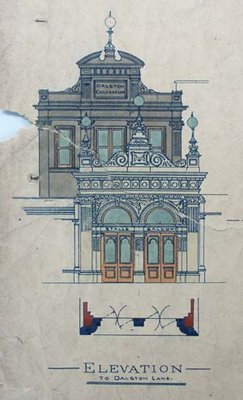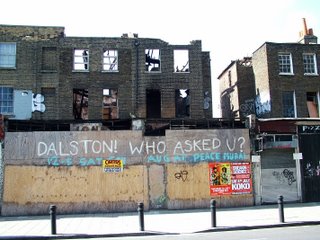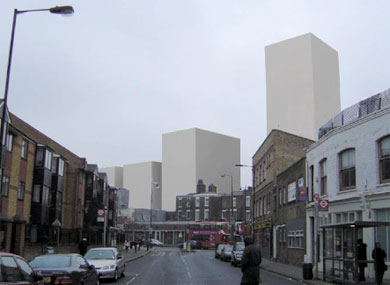The London Development Agency’s application for the demolition of the Dalston Theatre/Four Aces Club, and redevelopment of the Council’s DLS site has been recommended for approval by Hackney Council officers. The site is south of Dalston Lane between Beechwood Road and Roseberry Place and adjoins TfLs Dalston Junction railway site.The Planning Committee will consider the application on 13th July. The Council plan to sell the entire site to a private developer on a 125 year lease.
The plans are for:
• a high-density development of tall and very tall buildings of between 10 and 19 storeys. Buildings exceeding a maximum of 12-15 storeys directly contravene the Council’s own brief for the site which it agreed in July 2005. The towers will not create "
attractive landmarks" or "
enhance local character", contrary to London Plan policies, but will appear as an imposition derived from the Council’s desire to maximise density without regard to local conditions and streetscape.

•there are only 11-14 metres distance between the buildings leading to noise pollution and loss of privacy for the high-rise residents – the Council’s policy is for 21 metres distance between such buildings.

• 244 flats but only 24 of them will be 4-bed and over – failing to meet the greatest need locally for large family accommodation and the Council’s own policy requiring sufficient larger properties in new developments.
• the family size flats will be distributed vertically throughout the blocks – there will be children living at height, directly contravening the Council’s policy not to house children in its own stock above the 5th floor
• only 58 (24%) flats will be “affordable” to local people of which only 28 (11%) will be for rented social housing - failing to meet the Council’s own policy of 50% affordable housing of which 70% should be for rented social housing. All the social rented housing will be contained within one block

• of all the 553 new flats planned across the Council’s and TfL’s neighbouring development only 5% are for social rented housing and only 10.5% will be “affordable housing”. All the rest will be for sale.
• closure of Roseberry place to create a mainly granite-surfaced open space of 4900 sqm but only 2600sqm of which will in fact be usable by the public as such, the remainder being thoroughfares and service roads. Orientated north/south in a canyon between the towers most of the open space will on average be in shadow or darkness for 22 hours per day. Only 110sqm (2% of total open space) is reserved for children’s play.
• the towerblocks will cause overlooking and overshadowing of neighbouring homes on Beechwood Road many of which will fall below minimum daylight/sunlight levels.

• The towerblocks will create micro-climates - Dalston Lane will be made windier and recessed entrances are planned within the development to provide necessary shelter and protection
• a new library/archive resource over three floors which is to be rented back from the new landowner. Dalston’s existing CLR James Library, & Hackney Archives’ premises in the Rose Lipman Community Centre building, will thus become surplus to their present uses but the realisable capital value of these sites has been conveniently omitted from the “financial viability” assessment seeking to justify the demolitions and the development’s lack of affordable and family housing
• no arts cultural and entertainment uses are planned following demolition of Dalston Theatre/Club Four Aces, despite the Council’s UDP policy to resist the loss of, and to replace, such uses
• just 1% of total floor areas are allocated for community use/workshops
• only some 87 permanent jobs may be created by the development
• the provision for car parking fails to meet Hackney Council’s policy standard of 0.5<1 spaces per dwelling and this, together with 616 cars, 17 vans and 3 HGVs which are predicted to visit the site daily once construction is completed, will increase parking pressure locally. The new car parking spaces are likely to be offered for sale for £15,000 each.
•the buildings for demolition are said by the Council to be
“not of...such historic interest to warrant retention” – despite these including the oldest surviving circus building in the country

There is absolutely no doubt, based on my experience, that this building can be satisfactorily brought back to a situation where it can be reused. My experience suggests that repair and restoration will not be excessively expensive
Brian A Morton MBE C.Eng MICE Dip Conservation(AA) IHBC
Strucutral Engineer to Canterbury Cathedral, Bury St Edmunds Cathedral, Spitalfields TrustThe 1886 circus building was converted into a Victorian variety theatre in 1898, the largest cinema in the country in 1920, and a variety of uses since then inluding the Club Four Aces and Labrynth clubs since 1966. In 1999 the Council evicted all occupiers and allowed a process of "deliberate neglect" which has led to the destruction of the magnificent interiors.


Demolition is also proposed for the two earliest surviving Georgian houses on Dalston Lane which are locally listed and which the Council’s UDP policy is to retain and enhance and which are obviously capable of reuse.

On 6th February Council officers reported to Planning Sub-Committee that a structural engineer's report had been obtained by the Council which had concluded that major structural elements of the buildings had been damaged beyond repair. In fact the Council had not obtained such a report but the Committee voted to demolish the buildings.
More Tall StoreysThe Council has never intended the retention of any of these buildings although appearing to consult on the possibility.It agreed last summer to maximise the profit from the site and contribute any surplus to fund the construction of TfL's £39 million above-station concrete slab for which there is a £19 million shortfall. On 30 March the Council granted TfL planning permission to build a bus station, shops and 309 private flats for sale in high-rise blocks of up to 20 storeys, on the slab. Their consultant, Drivers Jonas, reports that "
throughout the project it has been the intention ...that any land value arising from the DLS proposals would contribute to the construction of the slab". TfL has stated to OPEN that retention of the buildings "
would adversely affect the viability of the air rights developments approved on Dalston Junction Interchange". Quite how the Council achieves "
best value" by giving away Council taxpayers' funds to finance TfL's private development, which has no affordable housing or local community benefit to speak of and which overshadows Hackney's own site, remains a mystery.
The buildings are presently protected by a High Court injunction, granted to OPEN on 6th April, which is the subject of a forthcoming Court hearing.
Public Consultation The Council’s brief for these sites, agreed in July 2005, included the statement that
“local residents have expressed the desire to retain Dalston’s character, diversity, cultural and architectural heritage, in addition to expressing the need for encouragement of small-scale businesses & the local and night time economy, and for development to have regard to the need for facilities for children, families and people with disabilities”
The brief also included the provision of
entertainment, community and arts facilities, to its stated objectives for the sites.
Few of these objectives will be realised by the proposed development and, in fact, the opportunity for many of them will be irreversibly destroyed.
The Council, the LDA and TfL have never held any public consultation or presentation where the current proposals for these neighbouring sites could be seen and discussed together despite the stated intention for them to be jointly developed in a “complementary” way. Consulting on each site separately from the other created a misleading impression of the combined cumulative effect of these controversial developments.
Our local MP, Meg Hillier, stated that
“Many of the broad parameters of development on this site have been set but the consultation will no doubt throw up residents’ and others’ views.”
This statement reaffirms OPEN’s view that the public consultation has not been “transparent, accessible and accountable” and nor has it “actively promoted (public) participation and involvement” but the strategy has been solely to tick off the landowners “legal consultation boxes” and there has been no intention on the Council’s & TfL’s part to vary the Masterplan which they and the GLA agencies decided upon in the summer of 2005.
“
Con” -
noun: a complicated confidence trick planned and executed with great care; - verb: to deprive of by deceit; - colloquial: abbreviation of consultation Save our past. Save our future.OPEN members do not want to live in the past, but we do want to live with it.The developers will not be building the new Jerusalem in Dalston but towerblock flats for sale which will overshadow and blight the area. We will see our children living at height with nothing for them except a tiny dark playground at the bottom of the canyon between the skyscrapers. It would be a hypocritical betrayal of Dalston’s community, and of hard won Council policies, to condemn future generations to this and wipe out our childrens’ and grandchildren’s heritage into the bargain.
















